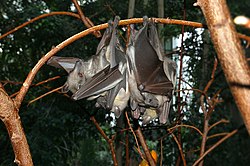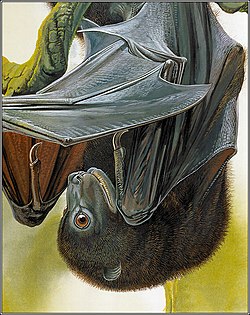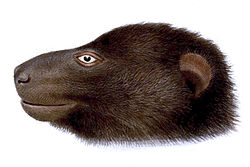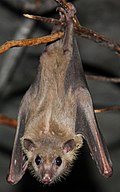Top Qs
Timeline
Chat
Perspective
List of pteropodids
Species in mammal family Pteropodidae From Wikipedia, the free encyclopedia
Remove ads
Pteropodidae is one of the twenty families of bats in the mammalian order Chiroptera and part of the Yinpterochiroptera suborder. Members of this family are called pteropodids, fruit bats, flying foxes, or megabats. They are found in Africa, Asia, and Australia, primarily in forests and caves, though some can be found in savannas, shrublands, wetlands, and rocky areas. They range in size from the long-tongued nectar bat, at 4 cm (2 in) plus a minute tail, to the great flying fox, at 37 cm (15 in) with no tail. Like all bats, pteropodids are capable of true and sustained flight, and have forearm lengths ranging from 3 cm (1 in) for several species to 23 cm (9 in) for the large flying fox, which has an overall wingspan of up to 1.7 m (5.6 ft).[1] Most species primarily or exclusively eat fruit, though the ten species of the subfamily Macroglossusinae primarily eat pollen and nectar and the sixteen species of the genus Nyctimene sometimes eat insects.[1] Most pteropodids do not have population estimates, though six species have been driven extinct in modern times: the Guam flying fox, large Palau flying fox, large Samoan flying fox, Percy Island flying fox, small Mauritian flying fox, and small Samoan flying fox, 29 species are categorized as endangered species, and 7 species are categorized as critically endangered: Bulmer's fruit bat, Philippine naked-backed fruit bat, Fijian monkey-faced bat, greater monkey-faced bat, montane monkey-faced bat, Aru flying fox, and Ontong Java flying fox, with populations as low as 50 or fewer.


The 193 extant species of Pteropodidae are divided into seven subfamilies: Cynopterinae, with 28 species in 15 genera; Eidolinae, with 2 species in a single genus; Harpyionycterinae, with 18 species in 4 genera; Nyctimeninae, with 18 species in 2 genera; Pteropodinae, with 75 species in 7 genera plus 6 extinct species; Rousettinae, with 41 species in 13 genera; and Macroglossusinae, with 10 species in 5 genera. Several extinct prehistoric pteropodid species have been discovered, though due to ongoing research and discoveries the exact number and categorization is not fixed.[2]
Remove ads
Conventions
Quick facts Conservation status, EX ...
| Conservation status | |
|---|---|
| EX | Extinct (6 species) |
| EW | Extinct in the wild (0 species) |
| CR | Critically endangered (7 species) |
| EN | Endangered (29 species) |
| VU | Vulnerable (35 species) |
| NT | Near threatened (19 species) |
| LC | Least concern (89 species) |
| Other categories | |
| DD | Data deficient (14 species) |
| NE | Not evaluated (0 species) |
Close
The author citation for the species or genus is given after the scientific name; parentheses around the author citation indicate that this was not the original taxonomic placement. Conservation status codes listed follow the International Union for Conservation of Nature (IUCN) Red List of Threatened Species. Range maps are provided wherever possible; if a range map is not available, a description of the pteropodid's range is provided. Ranges are based on the IUCN Red List for that species unless otherwise noted. All extinct species or subspecies listed alongside extant species went extinct after 1500 CE, and are indicated by a dagger symbol "†".
Remove ads
Classification
Summarize
Perspective
The family Pteropodidae consists of 193 extant species in seven subfamilies: Eidolinae, Harpyionycterinae, Nyctimeninae, Pteropodinae, Rousettinae, and Macroglossusinae. There are additionally six species that have been made extinct in the modern era in Pteropodinae.
Family Pteropodidae
- Subfamily Cynopterinae
- Genus Aethalops (sooty bats): two species
- Genus Alionycteris (Mindanao pygmy fruit bat): one species
- Genus Balionycteris (spotted-winged fruit bats): two species
- Genus Chironax (black-capped fruit bat): one species
- Genus Cynopterus (short-nosed fruit bats): seven species
- Genus Dyacopterus (dyak fruit bats): three species
- Genus Haplonycteris (Fischer's pygmy fruit bat): one species
- Genus Latidens (Salim Ali's fruit bat): one species
- Genus Megaerops (tailless fruit bats): three species
- Genus Otopteropus (Luzon fruit bat): one species
- Genus Penthetor (dusky fruit bat): one species
- Genus Ptenochirus (musky fruit bats): three species
- Genus Sphaerias (Blanford's fruit bat): one species
- Genus Thoopterus (swift fruit bats): two species
- Subfamily Eidolinae
- Genus Eidolon (palm bats): two species
- Subfamily Harpyionycterinae
- Genus Aproteles (Bulmer's fruit bat): one species
- Genus Boneia (Manado fruit bat): one species
- Genus Dobsonia (naked-backed fruit bats): fourteen species
- Genus Harpyionycteris (harpy fruit bats): two species
- Subfamily Nyctimeninae
- Genus Nyctimene (tube-nosed fruit bats): sixteen species
- Genus Paranyctimene (lesser tube-nosed fruit bats): two species
- Subfamily Pteropodinae
- Genus Acerodon (sharp-toothed flying foxes): five species
- Genus Desmalopex (white-winged flying foxes): two species
- Genus Mirimiri (Fijian monkey-faced bat): one species
- Genus Neopteryx (small-toothed fruit bat): one species
- Genus Pteralopex (monkey-faced bats): five species
- Genus Pteropus (flying foxes): sixty-five species (six extinct)
- Genus Styloctenium (stripe-faced fruit bats): two species
- Subfamily Rousettinae
- Genus Casinycteris (short-palated bats): two species
- Genus Eonycteris (dawn bats): three species
- Genus Epomophorus (epauletted bats): twelve species
- Genus Epomops (epauletted fruit bats): two species
- Genus Hypsignathus (hammer-headed bat): one species
- Genus Megaloglossus (long-tongued fruit bats): two species
- Genus Myonycteris (collared fruit bats): five species
- Genus Nanonycteris (Veldkamp's dwarf epauletted fruit bat): one species
- Genus Pilonycteris (Sulawesi rousette): one species
- Genus Plerotes (D'Anchieta's fruit bat): one species
- Genus Rousettus (rousettes): seven species
- Genus Scotonycteris (tear-drop bats): three species
- Genus Stenonycteris (long-haired fruit bat): one species
- Subfamily Macroglossusinae
- Genus Macroglossus (long-tongued fruit bats): two species
- Genus Melonycteris (black-bellied fruit bat): one species
- Genus Nesonycteris (Solomon Islands blossom bats): two species
- Genus Notopteris (long-tailed blossom bats): two species
- Genus Syconycteris (blossom bats): one species
Remove ads
Pteropodids
Summarize
Perspective
The following classification is based on the taxonomy described by the reference work Mammal Species of the World (2005), with augmentation by generally accepted proposals made since using molecular phylogenetic analysis, as supported by both the IUCN and the American Society of Mammalogists.[4]
Subfamily Cynopterinae
Main article: Cynopterinae
More information Common name, Scientific name and subspecies ...
| Common name | Scientific name and subspecies | Range | Size and ecology | IUCN status and estimated population |
|---|---|---|---|---|
| Borneo fruit bat | A. aequalis Allen, 1938 |
Northern island of Borneo |
Size: 5–7 cm (2–3 in) long, with no tail 4–5 cm (2 in) forearm length[5] Habitat: Forest and caves[6] |
LC
|
| Pygmy fruit bat
|
A. alecto (Thomas, 1923) Three subspecies
|
Southeastern Asia |
Size: 6–8 cm (2–3 in) long, with no tail 4–5 cm (2 in) forearm length[5] Habitat: Forest[7] |
LC
|
Close
More information Common name, Scientific name and subspecies ...
| Common name | Scientific name and subspecies | Range | Size and ecology | IUCN status and estimated population |
|---|---|---|---|---|
| Mindanao pygmy fruit bat
|
A. paucidentata Kock, 1969 |
Philippines |
Size: 6–8 cm (2–3 in) long, with no tail 4–5 cm (2 in) forearm length[8] Habitat: Forest[9] |
LC
|
Close
More information Common name, Scientific name and subspecies ...
| Common name | Scientific name and subspecies | Range | Size and ecology | IUCN status and estimated population |
|---|---|---|---|---|
| Malayan spotted-winged fruit bat
|
B. seimundi Kloss, 1921 |
Malaysia | Size: 5–7 cm (2–3 in) long, with no tail 4–5 cm (2 in) forearm length[5] Habitat: Forest[10] |
LC
|
| Spotted-winged fruit bat | B. maculata (Thomas, 1893) Two subspecies
|
Southeastern Asia |
Size: 5–8 cm (2–3 in) long, with no tail 3–5 cm (1–2 in) forearm length[5] Habitat: Forest[11] |
LC
|
Close
More information Common name, Scientific name and subspecies ...
| Common name | Scientific name and subspecies | Range | Size and ecology | IUCN status and estimated population |
|---|---|---|---|---|
| Black-capped fruit bat | C. melanocephalus (Temminck, 1825) Two subspecies
|
Southeastern Asia |
Size: 5–8 cm (2–3 in) long, with no tail 4–5 cm (2 in) forearm length[8] Habitat: Forest and caves[12] |
LC
|
Close
More information Common name, Scientific name and subspecies ...
| Common name | Scientific name and subspecies | Range | Size and ecology | IUCN status and estimated population |
|---|---|---|---|---|
| Greater short-nosed fruit bat | C. sphinx (Vahl, 1797) Six subspecies
|
Southern and southeastern Asia |
Size: 8–11 cm (3–4 in) long, plus 1–2 cm (0.4–0.8 in) tail 6–8 cm (2–3 in) forearm length[5] Habitat: Forest[13] |
LC
|
| Horsfield's fruit bat
|
C. horsfieldii Gray, 1843 Four subspecies
|
Southeastern Asia |
Size: 8–12 cm (3–5 in) long, plus 1–2 cm (0.4–0.8 in) tail 6–9 cm (2–4 in) forearm length[5] Habitat: Forest and caves[14] |
LC
|
| Indonesian short-nosed fruit bat | C. titthaecheilus (Temminck, 1825) Three subspecies
|
Southeastern Asia |
Size: 11–13 cm (4–5 in) long, plus 0.5–2 cm (0.2–0.8 in) tail 7–9 cm (3–4 in) forearm length[5] Habitat: Forest[15] |
LC
|
| Lesser short-nosed fruit bat | C. brachyotis (Müller, 1838) Eight subspecies
|
Southern and southeastern Asia |
Size: 7–10 cm (3–4 in) long, plus 1–2 cm (0.4–0.8 in) tail 5–7 cm (2–3 in) forearm length[5] Habitat: Forest[16] |
LC
|
| Minute fruit bat | C. minutus Miller, 1906 |
Southeastern Asia |
Size: 7–9 cm (3–4 in) long, plus 1–2 cm (0.4–0.8 in) tail 5–6 cm (2 in) forearm length[5] Habitat: Forest[17] |
LC
|
| Nusatenggara short-nosed fruit bat
|
C. nusatenggara Kitchener and Maharadatunkamsi, 1991 Three subspecies
|
Indonesia |
Size: About 9 cm (4 in) long, plus about 0.5 cm (0.2 in) tail 5–7 cm (2–3 in) forearm length[5] Habitat: Forest[18] |
LC
|
| Peters's fruit bat
|
C. luzoniensis (Peters, 1861) |
Southeastern Asia |
Size: 9–11 cm (4 in) long, plus 0.5–2 cm (0.20–0.79 in) tail 5–7 cm (2–3 in) forearm length[5] Habitat: Forest[19] |
LC
|
Close
More information Common name, Scientific name and subspecies ...
| Common name | Scientific name and subspecies | Range | Size and ecology | IUCN status and estimated population |
|---|---|---|---|---|
| Brooks's dyak fruit bat
|
D. brooksi (Thomas, 1920) |
Island of Sumatra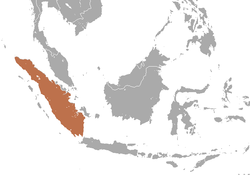 |
Size: 11–12 cm (4–5 in) long, plus 1–2 cm (0.4–0.8 in) tail 8–9 cm (3–4 in) forearm length[5] Habitat: Forest[20] |
VU
|
| Rickart's dyak fruit bat
|
D. rickarti (Thomas, 1920) |
Philippines |
Size: 13–15 cm (5–6 in) long, plus 1–3 cm (0.4–1.2 in) tail 9–10 cm (4–4 in) forearm length[5] Habitat: Forest and caves[21] |
EN
|
| Dayak fruit bat
|
D. spadiceus (Thomas, 1890) |
Southeastern Asia |
Size: 10–13 cm (4–5 in) long, plus 1–3 cm (0.4–1.2 in) tail 7–9 cm (3–4 in) forearm length[5] Habitat: Forest and caves[22] |
NT
|
Close
More information Common name, Scientific name and subspecies ...
| Common name | Scientific name and subspecies | Range | Size and ecology | IUCN status and estimated population |
|---|---|---|---|---|
| Fischer's pygmy fruit bat | H. fischeri Lawrence, 1939 |
Philippines |
Size: 6–8 cm (2–3 in) long, with no tail 4–6 cm (2 in) forearm length[8] Habitat: Forest[23] |
LC
|
Close
More information Common name, Scientific name and subspecies ...
| Common name | Scientific name and subspecies | Range | Size and ecology | IUCN status and estimated population |
|---|---|---|---|---|
| Salim Ali's fruit bat
|
L. salimalii Thonglongya, 1972 |
Southern India |
Size: 10–11 cm (4 in) long, with no tail 6–7 cm (2–3 in) forearm length[8] Habitat: Forest and caves[24] |
EN
|
Close
More information Common name, Scientific name and subspecies ...
| Common name | Scientific name and subspecies | Range | Size and ecology | IUCN status and estimated population |
|---|---|---|---|---|
| Javan tailless fruit bat
|
M. kusnotoi Hill & Boeadi, 1978 |
Indonesia |
Size: 5–8 cm (2–3 in) long, with no tail 4–6 cm (2 in) forearm length[5] Habitat: Forest[25] |
VU
|
| Ratanaworabhan's fruit bat
|
M. niphanae Yenbutra & Felten, 1983 |
Southeastern Asia |
Size: 7–9 cm (3–4 in) long, with no tail 5–7 cm (2–3 in) forearm length[5] Habitat: Forest[26] |
LC
|
| Tailless fruit bat | M. ecaudatus (Temminck, 1837) |
Southeastern Asia |
Size: 6–9 cm (2–4 in) long, with no tail 5–6 cm (2 in) forearm length[5] Habitat: Forest[27] |
LC
|
Close
More information Common name, Scientific name and subspecies ...
| Common name | Scientific name and subspecies | Range | Size and ecology | IUCN status and estimated population |
|---|---|---|---|---|
| Luzon fruit bat
|
O. cartilagonodus Kock, 1969 |
Philippines |
Size: 6–8 cm (2–3 in) long, with no tail 4–5 cm (2 in) forearm length[8] Habitat: Forest[28] |
LC
|
Close
More information Common name, Scientific name and subspecies ...
| Common name | Scientific name and subspecies | Range | Size and ecology | IUCN status and estimated population |
|---|---|---|---|---|
| Dusky fruit bat | P. lucasi Dobson, 1880 |
Southeastern Asia |
Size: 7–11 cm (3–4 in) long, plus 0.5–2 cm (0.2–0.8 in) tail 5–7 cm (2–3 in) forearm length[8] Habitat: Forest and caves[29] |
LC
|
Close
More information Common name, Scientific name and subspecies ...
| Common name | Scientific name and subspecies | Range | Size and ecology | IUCN status and estimated population |
|---|---|---|---|---|
| Greater musky fruit bat | P. jagori (Peters, 1861) |
Philippines |
Size: 11–13 cm (4–5 in) long, plus 0.5–2 cm (0.2–0.8 in) tail 7–10 cm (3–4 in) forearm length[5] Habitat: Forest[30] |
LC
|
| Lesser musky fruit bat
|
P. minor Yoshiyuki, 1979 |
Philippines |
Size: 10–12 cm (4–5 in) long, plus 0.5–2 cm (0.2–0.8 in) tail 7–8 cm (3 in) forearm length[5] Habitat: Forest[31] |
LC
|
| White-collared fruit bat
|
P. wetmorei Taylor, 1934 Two subspecies
|
Southeastern Asia |
Size: 7–8 cm (3 in) long, plus 0.3–0.5 cm (0.1–0.2 in) tail 4–6 cm (2 in) forearm length[5] Habitat: Forest[32] |
NT
|
Close
More information Common name, Scientific name and subspecies ...
| Common name | Scientific name and subspecies | Range | Size and ecology | IUCN status and estimated population |
|---|---|---|---|---|
| Blanford's fruit bat | S. blanfordi (Thomas, 1891) |
Southern and southeastern Asia |
Size: 7–9 cm (3–4 in) long, with no tail 5–7 cm (2–3 in) forearm length[5] Habitat: Forest[33] |
LC
|
Close
More information Common name, Scientific name and subspecies ...
| Common name | Scientific name and subspecies | Range | Size and ecology | IUCN status and estimated population |
|---|---|---|---|---|
| Suhaniah fruit bat
|
T. suhaniahae Maryanto, Yani, Prijono, & Wiantoro, 2012 |
Indonesia | Size: 8–11 cm (3–4 in) long, with no tail 7–9 cm (3–4 in) forearm length[5] Habitat: Forest[34] |
LC
|
| Swift fruit bat
|
T. nigrescens (Gray, 1870) |
Indonesia |
Size: 9–12 cm (4–5 in) long, plus about 0.5 cm (0.2 in) tail 7–9 cm (3–4 in) forearm length[5] Habitat: Forest[35] |
LC
|
Close
Subfamily Eidolinae
Main article: Eidolinae
More information Common name, Scientific name and subspecies ...
| Common name | Scientific name and subspecies | Range | Size and ecology | IUCN status and estimated population |
|---|---|---|---|---|
| Madagascan fruit bat | E. dupreanum Schlegel & Pollen, 1866 |
Western Madagascar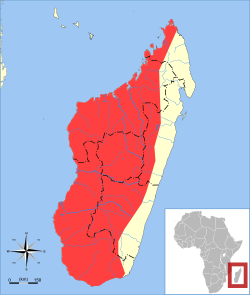 |
Size: 19–21 cm (7–8 in) long, plus 1–3 cm (0.4–1.2 in) 11–14 cm (4–6 in) forearm length[36] Habitat: Forest and caves[37] |
VU
|
| Straw-coloured fruit bat | E. helvum Kerr, 1792 Three subspecies
|
Sub-Saharan Africa and western Arabian Peninsula |
Size: 15–20 cm (6–8 in) long, plus 1–2 cm (0.4–0.8 in) 11–14 cm (4–6 in) forearm length[36] Habitat: Savanna and forest[38] |
NT
|
Close
Subfamily Harpyionycterinae
Main article: Harpyionycterinae
More information Common name, Scientific name and subspecies ...
| Common name | Scientific name and subspecies | Range | Size and ecology | IUCN status and estimated population |
|---|---|---|---|---|
| Bulmer's fruit bat
|
A. bulmerae (Menzies, 1977) |
New Guinea |
Size: About 25 cm (10 in) long, plus 3–4 cm (1–2 in) tail About 17 cm (7 in) forearm length[39] Habitat: Forest and caves[40] |
CR
|
Close
More information Common name, Scientific name and subspecies ...
| Common name | Scientific name and subspecies | Range | Size and ecology | IUCN status and estimated population |
|---|---|---|---|---|
| Manado fruit bat
|
B. bidens Jentink, 1879 |
Indonesia |
Size: About 19 cm (7 in) long, plus 2–3 cm (1 in) tail 9–11 cm (4 in) forearm length[39] Habitat: Forest and caves[41] |
VU
|
Close
More information Common name, Scientific name and subspecies ...
| Common name | Scientific name and subspecies | Range | Size and ecology | IUCN status and estimated population |
|---|---|---|---|---|
| Andersen's naked-backed fruit bat
|
D. anderseni Thomas, 1914 |
Papua New Guinea |
Size: 15–20 cm (6–8 in) long, plus 2–4 cm (1–2 in) tail 10–13 cm (4–5 in) forearm length[39] Habitat: Caves and forest[42] |
LC
|
| Bare-backed fruit bat | D. moluccensis (Quoy & Gaimard, 1830) |
Southeastern Asia and northern Australia |
Size: 18–25 cm (7–10 in) long, plus 2–5 cm (1–2 in) tail 12–17 cm (5–7 in) forearm length[39] Habitat: Forest, rocky areas, and caves[43] |
LC
|
| Beaufort's naked-backed fruit bat
|
D. beauforti Bergmans, 1975 |
Indonesia |
Size: 12–16 cm (5–6 in) long, plus 2–3 cm (1 in) tail 10–12 cm (4–5 in) forearm length[39] Habitat: Forest and caves[44] |
LC
|
| Biak naked-backed fruit bat
|
D. emersa Bergmans & Sarbini, 1985 |
Indonesia |
Size: 15–17 cm (6–7 in) long, plus 2–3 cm (1 in) tail 11–12 cm (4–5 in) forearm length[39] Habitat: Forest and caves[45] |
VU
|
| Greenish naked-backed fruit bat
|
D. viridis Heude, 1896 |
Indonesia |
Size: 15–18 cm (6–7 in) long, plus 2–4 cm (1–2 in) tail 10–12 cm (4–5 in) forearm length[39] Habitat: Forest and caves[46] |
LC
|
| Halmahera naked-backed fruit bat
|
D. crenulata K. Andersen, 1909 |
Indonesia |
Size: 16–20 cm (6–8 in) long, plus 2–4 cm (1–2 in) 11–14 cm (4–6 in) forearm length[36] Habitat: Forest, rocky areas, and caves[47] |
LC
|
| Lesser naked-backed fruit bat
|
D. minor Dobson, 1879 |
New Guinea |
Size: 10–14 cm (4–6 in) long, plus 0.5–3 cm (0.2–1.2 in) tail 7–10 cm (3–4 in) forearm length[39] Habitat: Forest[48] |
LC
|
| New Britain naked-backed fruit bat
|
D. praedatrix K. Andersen, 1909 |
Island of New Britain |
Size: 11–18 cm (4–7 in) long, plus 2–4 cm (1–2 in) 10–13 cm (4–5 in) forearm length[36] Habitat: Forest and caves[49] |
LC
|
| New Guinea naked-backed fruit bat
|
D. magna Thomas, 1905 |
Southeastern Asia and northern Australia | Size: 18–25 cm (7–10 in) long, plus 2–5 cm (1–2 in) tail 12–17 cm (5–7 in) forearm length[39] Habitat: Forest, rocky areas, and caves[50] |
LC
|
| Panniet naked-backed fruit bat
|
D. pannietensis Vis, 1905 Two subspecies
|
Papua New Guinea |
Size: 15–20 cm (6–8 in) long, plus 2–4 cm (1–2 in) 10–13 cm (4–5 in) forearm length[39] Habitat: Forest and caves[51] |
NT
|
| Philippine naked-backed fruit bat
|
D. chapmani Rabor, 1952 |
Philippines |
Size: Unknown length, plus 2–4 cm (1–2 in) 12–14 cm (5–6 in) forearm length[39] Habitat: Forest and caves[52] |
CR
|
| Solomon's naked-backed fruit bat
|
D. inermis K. Andersen, 1909 Two subspecies
|
Solomon Islands |
Size: 11–19 cm (4–7 in) long, plus 1–4 cm (0.4–1.6 in) 9–12 cm (4–5 in) forearm length[36] Habitat: Forest and caves[53] |
LC
|
| Sulawesi naked-backed fruit bat
|
D. exoleta K. Andersen, 1909 |
Indonesia |
Size: 15–19 cm (6–7 in) long, plus 2–4 cm (1–2 in) tail 10–13 cm (4–5 in) forearm length[39] Habitat: Forest and caves[54] |
LC
|
| Western naked-backed fruit bat | D. peronii (Geoffroy, 1810) Two subspecies
|
Indonesia |
Size: 14–16 cm (6–6 in) long, plus 2–4 cm (1–2 in) tail 11–13 cm (4–5 in) forearm length[39] Habitat: Forest and caves[55] |
LC
|
Close
More information Common name, Scientific name and subspecies ...
| Common name | Scientific name and subspecies | Range | Size and ecology | IUCN status and estimated population |
|---|---|---|---|---|
| Harpy fruit bat | H. whiteheadi Thomas, 1896 Two subspecies
|
Philippines |
Size: 13–16 cm (5–6 in) long, with no tail 8–10 cm (3–4 in) forearm length[39] Habitat: Forest[56] |
LC
|
| Sulawesi harpy fruit bat
|
H. celebensis Miller & Hollister, 1921 |
Indonesia |
Size: 11–16 cm (4–6 in) long, with no tail 7–10 cm (3–4 in) forearm length[39] Habitat: Forest[57] |
NT
|
Close
Subfamily Nyctimeninae
Main article: Nyctimeninae
More information Common name, Scientific name and subspecies ...
| Common name | Scientific name and subspecies | Range | Size and ecology | IUCN status and estimated population |
|---|---|---|---|---|
| Broad-striped tube-nosed fruit bat | N. aello (Thomas, 1900) |
Southeastern Asia |
Size: 10–15 cm (4–6 in) long, plus 1–4 cm (0.4–1.6 in) 7–9 cm (3–4 in) forearm length[36] Habitat: Forest[58] |
LC
|
| Common tube-nosed fruit bat | N. albiventer (Gray, 1863) Two subspecies
|
Southeastern Asia |
Size: 7–12 cm (3–5 in) long, plus 1–3 cm (0.4–1.2 in) 5–7 cm (2–3 in) forearm length[36] Habitat: Forest and savanna[59] |
LC
|
| Demonic tube-nosed fruit bat
|
N. masalai Smith & Hood, 1983 |
Papua New Guinea |
Size: 9–11 cm (4 in) long, plus 2–3 cm (1 in) 6–7 cm (2–3 in) forearm length[36] Habitat: Unknown[60] |
DD
|
| Dragon tube-nosed fruit bat
|
N. draconilla Thomas, 1922 |
New Guinea |
Size: 7–9 cm (3–4 in) long, plus 1–3 cm (0.4–1.2 in) 4–6 cm (2 in) forearm length[36] Habitat: Forest[61] |
DD
|
| Eastern tube-nosed bat | N. robinsoni Thomas, 1904 |
Eastern Australia |
Size: 8–10 cm (3–4 in) long, plus 2–3 cm (1 in) 6–7 cm (2–3 in) forearm length[36] Habitat: Forest[62] |
LC
|
| Island tube-nosed fruit bat | N. major (Dobson, 1877) Four subspecies
|
Papua New Guinea and Solomon Islands |
Size: 9–14 cm (4–6 in) long, plus 1–4 cm (0.4–1.6 in) 6–9 cm (2–4 in) forearm length[36] Habitat: Forest[63] |
LC
|
| Keast's tube-nosed fruit bat
|
N. keasti Kitchener, 1993 Three subspecies
|
Indonesia |
Size: 6–9 cm (2–4 in) long, plus 1–3 cm (0.4–1.2 in) 4–5 cm (2 in) forearm length[36] Habitat: Forest[64] |
NT
|
| Lesser tube-nosed bat
|
N. varius K. Andersen, 1910 |
Indonesia |
Size: Unknown length About 6 cm (2 in) forearm length[36] Habitat: Forest[65] |
VU
|
| Malaita tube-nosed fruit bat
|
N. malaitensis Phillips, 1968 |
Solomon Islands |
Size: About 12 cm (5 in) long, plus about 2 cm (1 in) about 7 cm (3 in) forearm length[36] Habitat: Forest[66] |
LC
|
| Mountain tube-nosed fruit bat
|
N. certans K. Andersen, 1912 |
New Guinea and New Britain |
Size: 8–12 cm (3–5 in) long, plus 1–3 cm (0.4–1.2 in) 5–7 cm (2–3 in) forearm length[36] Habitat: Forest[67] |
LC
|
| Nendo tube-nosed fruit bat
|
N. sanctacrucis (Troughton, 1931) |
Solomon Islands |
Size: 9–14 cm (4–6 in) long, plus 1–4 cm (0.4–1.6 in) 6–9 cm (2–4 in) forearm length[36] Habitat: Unknown[68] |
DD
|
| New Guinea tube-nosed bat
|
N. wrightae Irwin, 2017 |
New Guinea | Size: 8–9 cm (3–4 in) long, plus 1–3 cm (0.4–1.2 in) 5–7 cm (2–3 in) forearm length[36] Habitat: Forest and inland wetlands[69] |
LC
|
| Pallas's tube-nosed bat | N. cephalotes (Pallas, 1767) Two subspecies
|
Southeastern Asia |
Size: 8–10 cm (3–4 in) long, plus 1–3 cm (0.4–1.2 in) 6–7 cm (2–3 in) forearm length[36] Habitat: Forest[70] |
LC
|
| Philippine tube-nosed fruit bat
|
N. rabori Heaney & Peterson, 1984 |
Philippines |
Size: 11–13 cm (4–5 in) long, plus 1–3 cm (0.4–1.2 in) 7–9 cm (3–4 in) forearm length[36] Habitat: Forest[71] |
EN
|
| Round-eared tube-nosed fruit bat
|
N. cyclotis K. Andersen, 1910 |
Indonesia |
Size: Unknown length 5–6 cm (2 in) forearm length[36] Habitat: Forest[72] |
DD
|
| Umboi tube-nosed fruit bat
|
N. vizcaccia Thomas, 1914 Two subspecies
|
Papua New Guinea and Solomon Islands |
Size: 7–12 cm (3–5 in) long, plus 1–3 cm (0.4–1.2 in) 5–7 cm (2–3 in) forearm length[36] Habitat: Forest[73] |
LC
|
Close
More information Common name, Scientific name and subspecies ...
| Common name | Scientific name and subspecies | Range | Size and ecology | IUCN status and estimated population |
|---|---|---|---|---|
| Lesser tube-nosed fruit bat
|
P. raptor Tate, 1942 |
New Guinea and Indonesia |
Size: 6–10 cm (2–4 in) long, plus 1–3 cm (0.4–1.2 in) 4–6 cm (2 in) forearm length[36] Habitat: Forest[74] |
LC
|
| Steadfast tube-nosed fruit bat
|
P. tenax Bergmans, 2001 Two subspecies
|
New Guinea and Indonesia |
Size: Unknown length, plus 1–3 cm (0.4–1.2 in) 5–6 cm (2 in) forearm length[36] Habitat: Forest[75] |
LC
|
Close
Subfamily Pteropodinae
Main article: Pteropodinae
More information Common name, Scientific name and subspecies ...
| Common name | Scientific name and subspecies | Range | Size and ecology | IUCN status and estimated population |
|---|---|---|---|---|
| Giant golden-crowned flying fox | A. jubatus (Eschscholtz, 1831) Three subspecies
|
Philippines |
Size: 26–30 cm (10–12 in) long, with no tail 18–20 cm (7–8 in) forearm length[76] Habitat: Forest[77] |
EN
|
| Palawan fruit bat
|
A. leucotis (Sanborn, 1950) Two subspecies
|
Philippines |
Size: Unknown length, with no tail 13–17 cm (5–7 in) forearm length[76] Habitat: Forest[78] |
VU
|
| Sulawesi flying fox | A. celebensis (Peters, 1867) |
Indonesia |
Size: 19–20 cm (7–8 in) long, with no tail 13–15 cm (5–6 in) forearm length[76] Habitat: Forest[79] |
VU
|
| Sunda flying fox | A. mackloti (Temminck, 1837) Five subspecies
|
Indonesia |
Size: About 23 cm (9 in) long, with no tail 13–15 cm (5–6 in) forearm length[76] Habitat: Forest[80] |
VU
|
| Talaud flying fox
|
A. humilis K. Andersen, 1909 |
Philippines |
Size: Unknown length, with no tail about 14 cm (6 in) forearm length[76] Habitat: Forest[81] |
EN
|
Close
More information Common name, Scientific name and subspecies ...
| Common name | Scientific name and subspecies | Range | Size and ecology | IUCN status and estimated population |
|---|---|---|---|---|
| Small white-winged flying fox
|
D. microleucoptera Esselstyn, Garcia, Saulog, & Heaney, 2008 |
Philippines |
Size: 13–16 cm (5–6 in) long, with no tail 9–11 cm (4 in) forearm length[76] Habitat: Forest[82] |
EN
|
| White-winged flying fox | D. leucoptera Temminck, 1853 |
Philippines |
Size: 18–24 cm (7–9 in) long, with no tail 13–15 cm (5–6 in) forearm length[76] Habitat: Forest and grassland[83] |
VU
|
Close
More information Common name, Scientific name and subspecies ...
| Common name | Scientific name and subspecies | Range | Size and ecology | IUCN status and estimated population |
|---|---|---|---|---|
| Fijian monkey-faced bat | M. acrodonta (Hill & Beckon, 1978) |
Fiji |
Size: 17–20 cm (7–8 in) long, with no tail 11–13 cm (4–5 in) forearm length[76] Habitat: Forest[84] |
CR
|
Close
More information Common name, Scientific name and subspecies ...
| Common name | Scientific name and subspecies | Range | Size and ecology | IUCN status and estimated population |
|---|---|---|---|---|
| Small-toothed fruit bat | N. frosti Hayman, 1946 |
Indonesia |
Size: About 16 cm (6 in) long, with no tail 10–12 cm (4–5 in) forearm length[76] Habitat: Forest[85] |
EN
|
Close
More information Common name, Scientific name and subspecies ...
| Common name | Scientific name and subspecies | Range | Size and ecology | IUCN status and estimated population |
|---|---|---|---|---|
| Bougainville monkey-faced bat | P. anceps K. Andersen, 1909 |
Solomon Islands |
Size: 23–28 cm (9–11 in) long, with no tail 14–16 cm (6 in) forearm length[76] Habitat: Forest[86] |
EN
|
| Greater monkey-faced bat
|
P. flanneryi Helgen, 2005 |
Solomon Islands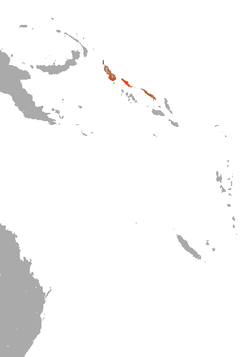 |
Size: 25–28 cm (10–11 in) long, with no tail 15–19 cm (6–7 in) forearm length[76] Habitat: Forest[87] |
CR
|
| Guadalcanal monkey-faced bat | P. atrata (Thomas, 1888) |
Solomon Islands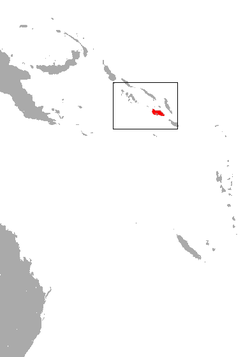 |
Size: 19–24 cm (7–9 in) long, with no tail 12–15 cm (5–6 in) forearm length[76] Habitat: Forest[88] |
EN
|
| Montane monkey-faced bat
|
P. pulchra Flannery, 1991 |
Solomon Islands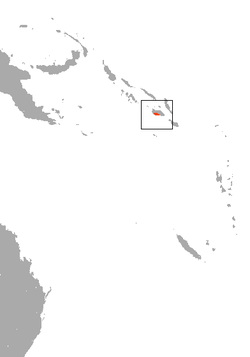 |
Size: About 16 cm (6 in) long, with no tail about 12 cm (5 in) forearm length[76] Habitat: Forest[89] |
CR
|
| New Georgian monkey-faced bat
|
P. taki Parnaby, 2002 |
Solomon Islands |
Size: About 19 cm (7 in) long, with no tail 11–13 cm (4–5 in) forearm length[76] Habitat: Forest[90] |
VU
|
Close
More information Common name, Scientific name and subspecies ...
| Common name | Scientific name and subspecies | Range | Size and ecology | IUCN status and estimated population |
|---|---|---|---|---|
| Admiralty flying fox | P. admiralitatum Thomas, 1894 Four subspecies
|
Papua New Guinea and Solomon Islands |
Size: 17–23 cm (7–9 in) long, with no tail 11–13 cm (4–5 in) forearm length[91] Habitat: Forest[92] |
LC
|
| Aldabra flying fox | P. aldabrensis True, 1893 |
Seychelles |
Size: 18–19 cm (7 in) long, with no tail 12–15 cm (5–6 in) forearm length[93] Habitat: Shrubland and forest[94] |
EN
|
| Andersen's flying fox
|
P. intermedius K. Andersen, 1908 |
Burma and Thailand |
Size: 22–25 cm (9–10 in) long, with no tail 16–18 cm (6–7 in) forearm length[95] Habitat: Forest[96] |
DD
|
| Aru flying fox | P. aruensis Peters, 1867 |
Indonesia |
Size: About 29 cm (11 in) long, with no tail about 19 cm (7 in) forearm length[93] Habitat: Unknown[97] |
CR
|
| Ashy-headed flying fox | P. caniceps Gray, 1870 Two subspecies
|
Indonesia |
Size: About 21 cm (8 in) long, with no tail 18–20 cm (7–8 in) forearm length[93] Habitat: Forest[98] |
VU
|
| Banks flying fox
|
P. fundatus Felten & Kock, 1972 |
Vanuatu |
Size: 13–16 cm (5–6 in) long, with no tail 9–11 cm (4 in) forearm length[95] Habitat: Forest[99] |
EN
|
| Big-eared flying fox | P. macrotis Peters, 1867 Two subspecies
|
New Guinea |
Size: 17–24 cm (7–9 in) long, with no tail 11–16 cm (4–6 in) forearm length[91] Habitat: Forest and shrubland[100] |
LC
|
| Bismarck masked flying fox | P. capistratus Peters, 1867 Two subspecies
|
Papua New Guinea |
Size: 14–20 cm (6–8 in) long, with no tail 10–13 cm (4–5 in) forearm length[95] Habitat: Forest[101] |
VU
|
| Black flying fox | P. alecto Temminck, 1837 Four subspecies
|
Southeastern Asia and northern Australia |
Size: 18–28 cm (7–11 in) long, with no tail 15–20 cm (6–8 in) forearm length[91] Habitat: Forest[102] |
LC
|
| Black-bearded flying fox | P. melanopogon Peters, 1867 |
Southeastern Asia |
Size: About 29 cm (11 in) long, with no tail 18–20 cm (7–8 in) forearm length[93] Habitat: Forest[103] |
EN
|
| Black-eared flying fox | P. melanotus Blyth, 1863 Five subspecies
|
Southeastern Asia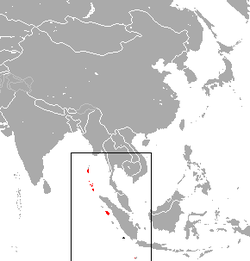 |
Size: Unknown length, with no tail 11–17 cm (4–7 in) forearm length[91] Habitat: Forest and inland wetlands[104] |
VU
|
| Bonin flying fox | P. pselaphon Lay, 1829 |
Bonin Islands in Japan |
Size: Unknown length, with no tail 13–15 cm (5–6 in) forearm length[95] Habitat: Forest[105] |
EN
|
| Caroline flying fox | P. molossinus Temminck, 1853 |
Micronesia |
Size: 14–15 cm (6 in) long, with no tail 9–10 cm (4 in) forearm length[91] Habitat: Forest[106] |
EN
|
| Ceram fruit bat | P. ocularis Peters, 1867 |
Indonesia |
Size: About 20 cm (8 in) long, with no tail 13–15 cm (5–6 in) forearm length[91] Habitat: Forest[107] |
VU
|
| Chuuk flying fox | P. pelagicus Kittlitz, 1836 |
Micronesia | Size: 15–19 cm (6–7 in) long, with no tail 10–11 cm (4 in) forearm length[91] Habitat: Forest[108] |
EN
|
| Dwarf flying fox | P. woodfordi Thomas, 1888 |
Solomon Islands |
Size: 9–15 cm (4–6 in) long, with no tail 8–10 cm (3–4 in) forearm length[91] Habitat: Forest[109] |
LC
|
| Geelvink Bay flying fox
|
P. pohlei Stein, 1933 |
Indonesia |
Size: 17–21 cm (7–8 in) long, with no tail 12–14 cm (5–6 in) forearm length[91] Habitat: Forest[110] |
VU
|
| Gilliard's flying fox
|
P. gilliardorum Van Deusen, 1969 |
Papua New Guinea |
Size: 15–18 cm (6–7 in) long, with no tail 11–12 cm (4–5 in) forearm length[91] Habitat: Forest[111] |
VU
|
| Gray flying fox | P. griseus Geoffroy, 1810 Three subspecies
|
Indonesia |
Size: 17–22 cm (7–9 in) long, with no tail 11–13 cm (4–5 in) forearm length[91] Habitat: Forest[112] |
VU
|
| Great flying fox | P. neohibernicus Peters, 1876 Two subspecies
|
New Guinea and Bismarck Archipelago |
Size: 23–37 cm (9–15 in) long, with no tail 16–22 cm (6–9 in) forearm length[91] Habitat: Forest and savanna[113] |
LC
|
| Grey-headed flying fox | P. poliocephalus Temminck, 1825 |
Southeastern Australia |
Size: 22–28 cm (9–11 in) long, with no tail 15–18 cm (6–7 in) forearm length[95] Habitat: Caves and forest[114] |
VU
|
| Guam flying fox†
|
P. tokudae Tate, 1934 |
Guam |
Size: Unknown Habitat: Forest[115] |
EX
|
| Indian flying fox | P. medius Temminck, 1825 |
Southern Asia |
Size: 22–25 cm (9–10 in) long, with no tail 16–18 cm (6–7 in) forearm length[93] Habitat: Forest[116] |
NT
|
| Insular flying fox | P. tonganus Quoy & Gaimard, 1830 Three subspecies
|
Eastern Oceania |
Size: 14–27 cm (6–11 in) long, with no tail 11–18 cm (4–7 in) forearm length[95] Habitat: Forest[117] |
LC
|
| Kei flying fox | P. keyensis Peters, 1867 |
Indonesia |
Size: About 29 cm (11 in) long, with no tail 17–19 cm (7–7 in) forearm length[95] Habitat: Unknown[118] |
DD
|
| Kosrae flying fox | P. ualanus Peters, 1883 |
Island of Kosrae in Micronesia |
Size: 18–23 cm (7–9 in) long, with no tail 12–14 cm (5–6 in) forearm length[95] Habitat: Forest[119] |
EN
|
| Large Palau flying fox†
|
P. pilosus K. Andersen, 1908 |
Micronesia | Size: Unknown Habitat: Unknown[120] |
EX
|
| Large Samoan flying fox†
|
P. coxi Helgen, Helgen, & Wilson, 2009 |
Samoa | Size: Unknown Habitat: Unknown[121] |
EX
|
| Large flying fox | P. vampyrus (Linnaeus, 1758) Six subspecies
|
Southeastern Asia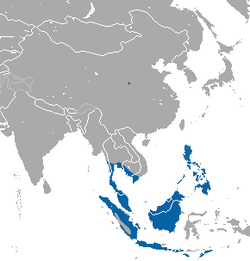 |
Size: 22–29 cm (9–11 in) long, with no tail 17–23 cm (7–9 in) forearm length[93] Habitat: Forest and inland wetlands[122] |
EN
|
| Lesser flying fox
|
P. mahaganus Sanborn, 1931 |
Papua New Guinea and Solomon Islands |
Size: 19–23 cm (7–9 in) long, with no tail 12–16 cm (5–6 in) forearm length[91] Habitat: Forest[123] |
LC
|
| Little golden-mantled flying fox
|
P. pumilus Miller, 1911 |
Philippines |
Size: 15–18 cm (6–7 in) long, with no tail 9–12 cm (4–5 in) forearm length[95] Habitat: Shrubland and forest[124] |
NT
|
| Little red flying fox | P. scapulatus Peters, 1862 |
Northern and eastern Australia |
Size: 12–20 cm (5–8 in) long, with no tail 11–15 cm (4–6 in) forearm length[91] Habitat: Forest and shrubland[125] |
LC
|
| Livingstone's fruit bat | P. livingstonii Gray, 1866 |
Comoros |
Size: About 34 cm (13 in) long, with no tail 16–18 cm (6–7 in) forearm length[95] Habitat: Forest[126] |
EN
|
| Lombok flying fox | P. lombocensis Dobson, 1878 Three subspecies
|
Indonesia |
Size: 15–18 cm (6–7 in) long, with no tail 11–13 cm (4–5 in) forearm length[91] Habitat: Forest[127] |
DD
|
| Lyle's flying fox | P. lylei K. Andersen, 1908 |
Southeastern Asia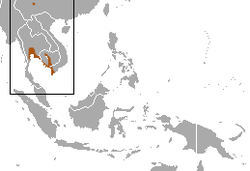 |
Size: About 20 cm (8 in) long, with no tail 14–16 cm (6 in) forearm length[95] Habitat: Forest[128] |
VU
|
| Madagascan flying fox | P. rufus Geoffroy, 1803 |
Madagascar |
Size: 23–27 cm (9–11 in) long, with no tail 15–18 cm (6–7 in) forearm length[93] Habitat: Forest[129] |
VU
|
| Makira flying fox
|
P. cognatus K. Andersen, 1908 |
Solomon Islands |
Size: 16–18 cm (6–7 in) long, with no tail 12–13 cm (5 in) forearm length[95] Habitat: Forest[130] |
VU
|
| Mariana fruit bat | P. mariannus Desmarest, 1822 Three subspecies
|
Mariana Islands and Caroline Islands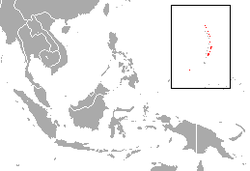 |
Size: 19–25 cm (7–10 in) long, with no tail 13–16 cm (5–6 in) forearm length[91] Habitat: Forest[131] |
EN
|
| Masked flying fox | P. personatus Temminck, 1825 |
Indonesia |
Size: 12–15 cm (5–6 in) long, with no tail 8–10 cm (3–4 in) forearm length[91] Habitat: Forest[132] |
LC
|
| Mauritian flying fox | P. niger (Kerr, 1792) |
Mauritius and La Réunion |
Size: About 23 cm (9 in) long, with no tail 14–18 cm (6–7 in) forearm length[93] Habitat: Forest[133] |
EN
|
| Moluccan flying fox | P. chrysoproctus Temminck, 1837 |
Indonesia |
Size: 19–26 cm (7–10 in) long, with no tail 16–18 cm (6–7 in) forearm length[93] Habitat: Forest[134] |
VU
|
| New Caledonia flying fox | P. vetulus Jouan, 1863 |
New Caledonia |
Size: 12–15 cm (5–6 in) long, with no tail 9–12 cm (4–5 in) forearm length[95] Habitat: Forest[135] |
NT
|
| New Ireland masked flying fox
|
P. ennisae Flannery & White, 1991 |
Papua New Guinea | Size: 15–19 cm (6–7 in) long, with no tail 10–12 cm (4–5 in) forearm length[95] Habitat: Forest[136] |
VU
|
| Nicobar flying fox
|
P. faunulus Miller, 1902 |
Nicobar Islands in India |
Size: About 17 cm (7 in) long, with no tail 11–13 cm (4–5 in) forearm length[95] Habitat: Forest[137] |
EN
|
| Okinawa flying fox
|
P. loochoensis Gray, 1870 |
Japan |
Size: 19–25 cm (7–10 in) long, with no tail 13–16 cm (5–6 in) forearm length[91] Habitat: Unknown[138] |
DD
|
| Ontong Java flying fox
|
P. howensis Troughton, 1931 |
Solomon Islands |
Size: 17–20 cm (7–8 in) long, with no tail 11–13 cm (4–5 in) forearm length[95] Habitat: Forest[139] |
CR
|
| Ornate flying fox
|
P. ornatus Gray, 1870 Two subspecies
|
New Caledonia |
Size: 18–19 cm (7–7 in) long, with no tail 14–17 cm (6–7 in) forearm length[91] Habitat: Forest[140] |
VU
|
| Pelew flying fox | P. pelewensis K. Andersen, 1908 |
Palau |
Size: 14–32 cm (6–13 in) long, with no tail 10–14 cm (4–6 in) forearm length[91] Habitat: Forest and savanna[141] |
VU
|
| Pemba flying fox | P. voeltzkowi Matschie, 1909 |
Island of Pemba in Tanzania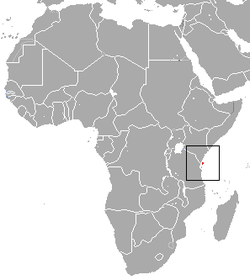 |
Size: 22–26 cm (9–10 in) long, with no tail 14–17 cm (6–7 in) forearm length[95] Habitat: Forest[142] |
VU
|
| Percy Island flying fox† | P. brunneus Dobson, 1878. |
Percy Island in Australia | Size: Unknown Habitat: Unknown[143] |
EX
|
| Philippine gray flying fox
|
P. speciosus K. Andersen, 1908 |
Indonesia and Philippines |
Size: Unknown length, with no tail 12–13 cm (5 in) forearm length[91] Habitat: Forest[144] |
DD
|
| Rennell flying fox
|
P. rennelli Troughton, 1929. |
Solomon Islands |
Size: 14–19 cm (6–7 in) long, with no tail 9–13 cm (4–5 in) forearm length[95] Habitat: Forest[145] |
EN
|
| Rodrigues flying fox | P. rodricensis Dobson, 1878 |
Island of Rodrigues |
Size: 15–20 cm (6–8 in) long, with no tail 12–13 cm (5 in) forearm length[93] Habitat: Forest[146] |
EN
|
| Ryukyu flying fox | P. dasymallus Temminck, 1825 Five subspecies
|
Eastern Asia |
Size: 18–23 cm (7–9 in) long, with no tail 12–15 cm (5–6 in) forearm length[95] Habitat: Forest[147] |
VU
|
| Samoa flying fox | P. samoensis Peale, 1848 Two subspecies
|
Samoa and Fiji |
Size: 17–22 cm (7–9 in) long, with no tail 12–16 cm (5–6 in) forearm length[95] Habitat: Forest[148] |
NT
|
| Seychelles fruit bat | P. seychellensis Kerr, 1792 Two subspecies
|
Seychelles, Comoros, and Mafia Island |
Size: About 23 cm (9 in) long, with no tail 14–16 cm (6 in) forearm length[93] Habitat: Forest[149] |
LC
|
| Small Mauritian flying fox† | P. subniger Kerr, 1792 |
Mascarene Islands |
Size: Unknown Habitat: Unknown and forest[150] |
EX
|
| Small Samoan flying fox†
|
P. allenorum Helgen, Helgen, & Wilson, 2009 |
Samoa | Size: Unknown Habitat: Unknown[151] |
EX
|
| Small flying fox | P. hypomelanus Temminck, 1853 Sixteen subspecies
|
Southeastern Asia |
Size: Unknown length, with no tail 11–17 cm (4–7 in) forearm length[91] Habitat: Forest[152] |
NT
|
| Solomons flying fox
|
P. rayneri Gray, 1870 Five subspecies
|
Solomon Islands |
Size: 23–27 cm (9–11 in) long, with no tail 13–19 cm (5–7 in) forearm length[95] Habitat: Forest[153] |
NT
|
| Spectacled flying fox | P. conspicillatus Gould, 1850 Two subspecies
|
Southeastern Asia and northern Australia |
Size: 23–29 cm (9–11 in) long, with no tail 15–19 cm (6–7 in) forearm length[91] Habitat: Forest[154] |
EN
|
| Temminck's flying fox | P. temminckii Peters, 1867 Two subspecies
|
Indonesia |
Size: 15–17 cm (6–7 in) long, with no tail 9–11 cm (4 in) forearm length[95] Habitat: Forest[155] |
VU
|
| Temotu flying fox
|
P. nitendiensis Sanborn, 1930 |
Solomon Islands |
Size: 17–18 cm (7 in) long, with no tail 11–13 cm (4–5 in) forearm length[95] Habitat: Forest[156] |
EN
|
| Vanikoro flying fox | P. tuberculatus Peters, 1869 |
Solomon Islands |
Size: 13–17 cm (5–7 in) long, with no tail 11–13 cm (4–5 in) forearm length[95] Habitat: Forest[157] |
EN
|
| Vanuatu flying fox | P. anetianus Gray, 1870 Seven subspecies
|
Vanuatu |
Size: 15–20 cm (6–8 in) long, with no tail 11–14 cm (4–6 in) forearm length[95] Habitat: Forest[158] |
VU
|
Close
More information Common name, Scientific name and subspecies ...
| Common name | Scientific name and subspecies | Range | Size and ecology | IUCN status and estimated population |
|---|---|---|---|---|
| Mindoro stripe-faced fruit bat
|
S. mindorense Esselstyn, 2007 |
Philippines (in red) |
Size: 14–18 cm (6–7 in) long, with no tail 10–12 cm (4–5 in) forearm length[76] Habitat: Forest[159] |
EN
|
| Sulawesi stripe-faced fruit bat | S. wallacei (Gray, 1866) |
Indonesia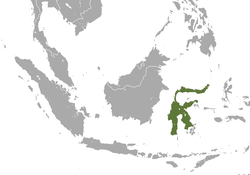 |
Size: 14–20 cm (6–8 in) long, with no tail 9–11 cm (4 in) forearm length[76] Habitat: Forest[160] |
NT
|
Close
Subfamily Rousettinae
Main article: Rousettinae
More information Common name, Scientific name and subspecies ...
| Common name | Scientific name and subspecies | Range | Size and ecology | IUCN status and estimated population |
|---|---|---|---|---|
| Campo-Ma'an fruit bat
|
C. campomaanensis Hassanin, 2014 |
Cameroon |
Size: Unknown, with no tail about 7 cm (3 in) forearm length[8] Habitat: Forest[161] |
DD
|
| Short-palated fruit bat
|
C. argynnis Thomas, 1910 |
Central Africa |
Size: 7–10 cm (3–4 in) long, with no tail 5–7 cm (2–3 in) forearm length[8] Habitat: Forest[162] |
LC
|
Close
More information Common name, Scientific name and subspecies ...
| Common name | Scientific name and subspecies | Range | Size and ecology | IUCN status and estimated population |
|---|---|---|---|---|
| Cave nectar bat | E. spelaea (Dobson, 1871) Four subspecies
|
Southern and southeastern Asia |
Size: 7–13 cm (3–5 in) long, plus 1–3 cm (0.4–1.2 in) tail 6–8 cm (2–3 in) forearm length[8] Habitat: Forest and caves[163] |
LC
|
| Greater nectar bat
|
E. major K. Andersen, 1910 |
Island of Borneo |
Size: 12–13 cm (5 in) long, plus 1–3 cm (0.4–1.2 in) tail 6–9 cm (2–4 in) forearm length[8] Habitat: Forest and caves[164] |
NT
|
| Philippine dawn bat
|
E. robusta Miller, 1913 |
Philippines |
Size: 10–13 cm (4–5 in) long, plus 2–3 cm (1 in) tail 6–9 cm (2–4 in) forearm length[8] Habitat: Forest and caves[165] |
VU
|
Close
More information Common name, Scientific name and subspecies ...
| Common name | Scientific name and subspecies | Range | Size and ecology | IUCN status and estimated population |
|---|---|---|---|---|
| Angolan epauletted fruit bat | E. angolensis Gray, 1870 |
Angola and Namibia |
Size: 13–16 cm (5–6 in) long, with no tail 8–10 cm (3–4 in) forearm length[166] Habitat: Savanna[167] |
NT
|
| Ansell's epauletted fruit bat
|
E. anselli Bergmans & van Strien, 2004 |
Malawi |
Size: 10–15 cm (4–6 in) long, plus 0.2–0.5 cm (0.1–0.2 in) tail 6–8 cm (2–3 in) forearm length[166] Habitat: Savanna[168] |
DD
|
| Dobson's epauletted fruit bat
|
E. dobsonii Bocage, 1899 |
Southern Africa |
Size: 13–19 cm (5–7 in) long, plus 0–0.1 cm (0.00–0.04 in) tail 8–10 cm (3–4 in) forearm length[166] Habitat: Savanna[169] |
LC
|
| East African epauletted fruit bat
|
E. minimus Claessen & De Vree, 1991 |
Eastern Africa |
Size: 9–12 cm (4–5 in) long, with no tail 5–7 cm (2–3 in) forearm length[166] Habitat: Forest, savanna, and rocky areas[170] |
LC
|
| Ethiopian epauletted fruit bat | E. labiatus Temminck, 1837 |
Central and eastern Africa |
Size: 9–12 cm (4–5 in) long, plus 0–0.5 cm (0.0–0.2 in) tail 5–8 cm (2–3 in) forearm length[166] Habitat: Forest, savanna, shrubland, and grassland[171] |
LC
|
| Gambian epauletted fruit bat | E. gambianus (Ogilby, 1835) Two subspecies
|
Equatorial Africa |
Size: 10–17 cm (4–7 in) long, plus 0–1 cm (0.0–0.4 in) tail 7–10 cm (3–4 in) forearm length[166] Habitat: Forest and savanna[172] |
LC
|
| Hayman's dwarf epauletted fruit bat
|
E. intermedius Hayman, 1963 |
Angola and Democratic Republic of the Congo |
Size: Unknown length, plus 0.3–0.5 cm (0.1–0.2 in) tail 5–7 cm (2–3 in) forearm length[39] Habitat: Forest and savanna[173] |
DD
|
| Lesser Angolan epauletted fruit bat
|
E. grandis (Sanborn, 1950) |
Angola and Democratic Republic of the Congo |
Size: About 10 cm (4 in) long, plus 0.4–1 cm (0.2–0.4 in) tail 6–7 cm (2–3 in) forearm length[39] Habitat: Forest and savanna[174] |
DD
|
| Minor epauletted fruit bat | E. minor Dobson, 1879 |
Central and eastern Africa and western Arabian Peninsula |
Size: 9–12 cm (4–5 in) long, with no tail 5–7 cm (2–3 in) forearm length[166] Habitat: Forest, savanna, shrubland, and grassland[175] |
LC
|
| Peters's dwarf epauletted fruit bat | E. pusillus (Peters, 1867) |
Sub-Saharan Africa |
Size: 6–11 cm (2–4 in) long, plus 0–0.5 cm (0.0–0.2 in) tail 4–6 cm (2 in) forearm length[39] Habitat: Forest, savanna, and shrubland[176] |
LC
|
| Peters's epauletted fruit bat | E. crypturus Peters, 1852 |
Southeastern Africa |
Size: 11–17 cm (4–7 in) long, plus 0–0.5 cm (0.0–0.2 in) tail 7–9 cm (3–4 in) forearm length[166] Habitat: Savanna[177] |
LC
|
| Wahlberg's epauletted fruit bat | E. wahlbergi (Sundevall, 1846) |
Southern Africa |
Size: 10–19 cm (4–7 in) long, plus 0–1 cm (0.0–0.4 in) tail 6–10 cm (2–4 in) forearm length[166] Habitat: Forest, savanna, and shrubland[178] |
LC
|
Close
More information Common name, Scientific name and subspecies ...
| Common name | Scientific name and subspecies | Range | Size and ecology | IUCN status and estimated population |
|---|---|---|---|---|
| Buettikofer's epauletted fruit bat | E. buettikoferi (Matschie, 1899) |
Western Africa |
Size: 10–20 cm (4–8 in) long, with no tail 8–11 cm (3–4 in) forearm length[166] Habitat: Forest, savanna, and shrubland[179] |
LC
|
| Franquet's epauletted fruit bat | E. franqueti (Tomes, 1860) |
Central Africa |
Size: 11–18 cm (4–7 in) long, plus 0–0.1 cm (0.00–0.04 in) tail 7–11 cm (3–4 in) forearm length[166] Habitat: Forest and savanna[180] |
LC
|
Close
More information Common name, Scientific name and subspecies ...
| Common name | Scientific name and subspecies | Range | Size and ecology | IUCN status and estimated population |
|---|---|---|---|---|
| Hammer-headed bat | H. monstrosus H. Allen, 1861 |
Western and central Africa |
Size: 16–30 cm (6–12 in) long, with no tail 11–14 cm (4–6 in) forearm length[166] Habitat: Forest and savanna[181] |
LC
|
Close
More information Common name, Scientific name and subspecies ...
| Common name | Scientific name and subspecies | Range | Size and ecology | IUCN status and estimated population |
|---|---|---|---|---|
| Azagnyi fruit bat
|
M. azagnyi Nesi, Kadjo, & Hassanin, 2012 |
Western Africa | Size: 6–9 cm (2–4 in) long, with no tail 3–5 cm (1–2 in) forearm length[166] Habitat: Forest[182] |
LC
|
| Woermann's bat | M. woermanni Pagenstecher, 1885 |
Western and central Africa |
Size: 6–8 cm (2–3 in) long, with no tail 3–5 cm (1–2 in) forearm length[166] Habitat: Forest[183] |
LC
|
Close
More information Common name, Scientific name and subspecies ...
| Common name | Scientific name and subspecies | Range | Size and ecology | IUCN status and estimated population |
|---|---|---|---|---|
| Angolan rousette | M. angolensis (Bocage, 1898) |
Sub-Saharan Africa |
Size: 9–14 cm (4–6 in) long, plus 0.5–3 cm (0.2–1.2 in) tail 6–9 cm (2–4 in) forearm length[166] Habitat: Forest, savanna, shrubland, grassland, rocky areas, and caves[184] |
LC
|
| East African little collared fruit bat | M. relicta Bergmans, 1980 |
Eastern Africa |
Size: 9–12 cm (4–5 in) long, plus 0.5–2 cm (0.2–0.8 in) tail 6–8 cm (2–3 in) forearm length[166] Habitat: Savanna and forest[185] |
LC
|
| Little collared fruit bat | M. torquata Dobson, 1878 |
Western and central Africa |
Size: 8–13 cm (3–5 in) long, plus 0–2 cm (0–1 in) tail 5–7 cm (2–3 in) forearm length[166] Habitat: Forest[186] |
LC
|
| Sierra Leone collared fruit bat
|
M. leptodon K. Andersen, 1908 |
Western Africa | Size: 8–12 cm (3–5 in) long, plus 0–2 cm (0–1 in) tail 5–7 cm (2–3 in) forearm length[166] Habitat: Forest[187] |
LC
|
| São Tomé collared fruit bat
|
M. brachycephala (Bocage, 1889) |
São Tomé and Príncipe |
Size: 9–11 cm (4 in) long, plus about 0.1 cm (0.04 in) tail 6–7 cm (2–3 in) forearm length[166] Habitat: Forest[188] |
EN
|
Close
More information Common name, Scientific name and subspecies ...
| Common name | Scientific name and subspecies | Range | Size and ecology | IUCN status and estimated population |
|---|---|---|---|---|
| Veldkamp's dwarf epauletted fruit bat | N. veldkampii (Jentink, 1888) |
Western Africa |
Size: 6–9 cm (2–4 in) long, plus 0.1–0.5 cm (0.0–0.2 in) tail 4–6 cm (2 in) forearm length[166] Habitat: Forest and savanna[189] |
LC
|
Close
More information Common name, Scientific name and subspecies ...
| Common name | Scientific name and subspecies | Range | Size and ecology | IUCN status and estimated population |
|---|---|---|---|---|
| Sulawesi rousette | P. celebensis (K. Andersen, 1907) |
Indonesia |
Size: 8–11 cm (3–4 in) long, plus 2–3 cm (1 in) tail 7–8 cm (3 in) forearm length[8] Habitat: Forest and caves[190] |
LC
|
Close
More information Common name, Scientific name and subspecies ...
| Common name | Scientific name and subspecies | Range | Size and ecology | IUCN status and estimated population |
|---|---|---|---|---|
| D'Anchieta's fruit bat
|
P. anchietae (Seabra, 1900) |
Southern Africa |
Size: 7–10 cm (3–4 in) long, with no tail 4–6 cm (2 in) forearm length[166] Habitat: Forest and savanna[191] |
LC
|
Close
More information Common name, Scientific name and subspecies ...
| Common name | Scientific name and subspecies | Range | Size and ecology | IUCN status and estimated population |
|---|---|---|---|---|
| Bare-backed rousette | R. spinalatus Bergmans & Hill, 1980 |
Southeastern Asia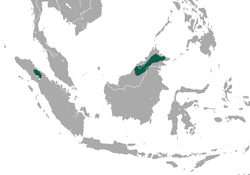 |
Size: About 11 cm (4 in) long, plus 0.5–2 cm (0.2–0.8 in) tail 8–9 cm (3–4 in) forearm length[8] Habitat: Forest and caves[192] |
VU
|
| Comoro rousette
|
R. obliviosus Kock, 1978 |
Comoros Islands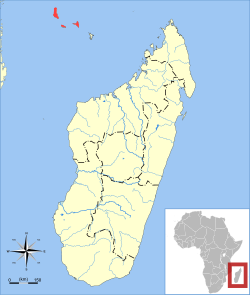 |
Size: 12–15 cm (5–6 in) long, plus 1–3 cm (0.4–1.2 in) tail 7–8 cm (3 in) forearm length[8] Habitat: Forest and caves[193] |
VU
|
| Egyptian fruit bat | R. aegyptiacus (Geoffroy, 1810) Six subspecies
|
Africa and western Asia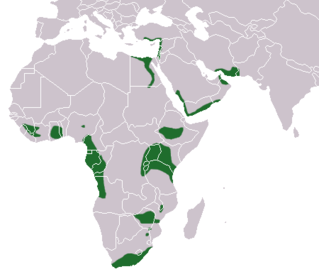 |
Size: 13–20 cm (5–8 in) long, plus 0.5–3 cm (0.2–1.2 in) tail 8–11 cm (3–4 in) forearm length[8] Habitat: Forest, savanna, shrubland, grassland, caves, and desert[194] |
LC
|
| Geoffroy's rousette | R. amplexicaudatus Geoffroy, 1810 Five subspecies
|
Southeastern Asia |
Size: 12–16 cm (5–6 in) long, plus 1–3 cm (0.4–1.2 in) tail 7–10 cm (3–4 in) forearm length[8] Habitat: Forest, rocky areas, and caves[195] |
LC
|
| Leschenault's rousette | R. leschenaultii Desmarest, 1820 Three subspecies
|
Southern and southeastern Asia |
Size: 8–13 cm (3–5 in) long, plus 1–2 cm (0.4–0.8 in) tail 7–10 cm (3–4 in) forearm length[8] Habitat: Forest and caves[196] |
NT
|
| Linduan rousette
|
R. linduensis Maryanto & Yani, 2003 |
Indonesia |
Size: 10–12 cm (4–5 in) long, plus 2–4 cm (1–2 in) tail 7–8 cm (3 in) forearm length[8] Habitat: Forest[197] |
DD
|
| Madagascan rousette | R. madagascariensis Grandidier, 1928 |
Madagascar |
Size: 11–15 cm (4–6 in) long, plus 0.5–2 cm (0–1 in) tail 6–8 cm (2–3 in) forearm length[8] Habitat: Forest and caves[198] |
VU
|
Close
More information Common name, Scientific name and subspecies ...
| Common name | Scientific name and subspecies | Range | Size and ecology | IUCN status and estimated population |
|---|---|---|---|---|
| Bergmans's fruit bat
|
S. bergmansi Hassanin, Khouider, Gembu, Goodman, Kadjo, Nesi, Pourrut, Nakouné, & Bonillo, 2014 |
Western and central Africa | Size: 6–9 cm (2–4 in) long, with no tail 4–6 cm (2 in) forearm length[8] Habitat: Forest[199] |
LC
|
| Hayman's fruit bat
|
S. occidentalis Hayman, 1947 |
Western Africa | Size: 6–9 cm (2–4 in) long, with no tail 4–6 cm (2 in) forearm length[8] Habitat: Forest[200] |
LC
|
| Zenker's fruit bat | S. zenkeri Matschie, 1894 Two subspecies
|
Western and central Africa |
Size: 6–9 cm (2–4 in) long, with no tail 4–6 cm (2 in) forearm length[8] Habitat: Forest[201] |
NT
|
Close
More information Common name, Scientific name and subspecies ...
| Common name | Scientific name and subspecies | Range | Size and ecology | IUCN status and estimated population |
|---|---|---|---|---|
| Long-haired fruit bat | S. lanosus (Thomas, 1906) |
Eastern Africa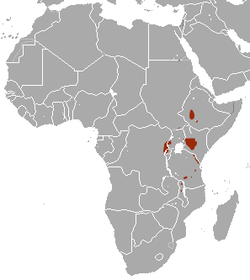 |
Size: 11–18 cm (4–7 in) long, plus 0.5–3 cm (0.2–1.2 in) tail 8–10 cm (3–4 in) forearm length[166] Habitat: Forest, savanna, and shrubland[202] |
LC
|
Close
Subfamily Macroglossusinae
Main article: Macroglossusinae
More information Common name, Scientific name and subspecies ...
| Common name | Scientific name and subspecies | Range | Size and ecology | IUCN status and estimated population |
|---|---|---|---|---|
| Long-tongued fruit bat | M. sobrinus K. Andersen, 1911 |
Southeastern Asia |
Size: 7–9 cm (3–4 in) long, plus 0–1 cm (0.0–0.4 in) tail 3–6 cm (1–2 in) forearm length[39] Habitat: Forest[203] |
LC
|
| Long-tongued nectar bat | M. minimus (Geoffroy, 1810) |
Southeastern Asia and northern Australia |
Size: 4–8 cm (2–3 in) long, plus 0–1 cm (0.0–0.4 in) tail 3–5 cm (1–2 in) forearm length[39] Habitat: Forest[204] |
LC
|
Close
More information Common name, Scientific name and subspecies ...
| Common name | Scientific name and subspecies | Range | Size and ecology | IUCN status and estimated population |
|---|---|---|---|---|
| Black-bellied fruit bat | M. melanops Dobson, 1877 |
Papua New Guinea |
Size: 7–11 cm (3–4 in) long, with no tail 5–7 cm (2–3 in) forearm length[76] Habitat: Forest and caves[205] |
LC
|
Close
More information Common name, Scientific name and subspecies ...
| Common name | Scientific name and subspecies | Range | Size and ecology | IUCN status and estimated population |
|---|---|---|---|---|
| Fardoulis's blossom bat
|
N. fardoulisi Flannery, 1993 Four subspecies
|
Solomon Islands |
Size: 8–10 cm (3–4 in) long, with no tail 5–7 cm (2–3 in) forearm length[76] Habitat: Forest[206] |
NT
|
| Woodford's fruit bat | N. woodfordi Thomas, 1887 Two subspecies
|
Solomon Islands |
Size: 8–11 cm (3–4 in) long, with no tail 4–6 cm (2 in) forearm length[76] Habitat: Forest[207] |
LC
|
Close
More information Common name, Scientific name and subspecies ...
| Common name | Scientific name and subspecies | Range | Size and ecology | IUCN status and estimated population |
|---|---|---|---|---|
| Long-tailed fruit bat | N. macdonaldi Gray, 1859 |
Fiji and Vanuatu |
Size: 9–11 cm (4 in) long, plus 5–7 cm (2–3 in) tail 6–7 cm (2–3 in) forearm length[76] Habitat: Forest and caves[208] |
VU
|
| New Caledonia blossom bat
|
N. neocaledonica Trouessart, 1908 |
New Caledonia |
Size: 9–10 cm (4–4 in) long, plus 4–6 cm (2 in) tail 5–6 cm (2 in) forearm length[76] Habitat: Caves and forest[209] |
EN
|
Close
More information Common name, Scientific name and subspecies ...
| Common name | Scientific name and subspecies | Range | Size and ecology | IUCN status and estimated population |
|---|---|---|---|---|
| Common blossom bat | S. australis (Peters, 1867) Seven subspecies
|
Southeastern Asia and northern Australia |
Size: 5–8 cm (2–3 in) long, with no tail 3–5 cm (1–2 in) forearm length[39] Habitat: Forest, savanna, and shrubland[210] |
LC
|
| Halmahera blossom bat
|
S. carolinae Rozendaal, 1984 |
Indonesia |
Size: 8–10 cm (3–4 in) long, with no tail 5–7 cm (2–3 in) forearm length[39] Habitat: Forest[211] |
NT
|
| Moss-forest blossom bat
|
S. hobbit Ziegler, 1982 |
New Guinea |
Size: 5–8 cm (2–3 in) long, with no tail 4–6 cm (2 in) forearm length[39] Habitat: Forest[212] |
LC
|
Close
Remove ads
References
Sources
Wikiwand - on
Seamless Wikipedia browsing. On steroids.
Remove ads
Remove ads













